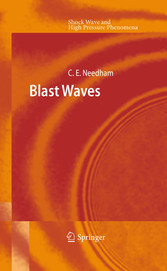Suchen und Finden
Preface
6
Contents
7
Chapter 1: Introduction
12
Introduction
12
Chapter 2: Some Basic Air Blast Definitions
13
Formation of a Shock Wave
15
Methods for Generating a Shock Wave
16
Chapter 3: The Rankine-Hugoniot Relations
19
Real Air Effects on Gamma
20
Variable gamma Rankine-Hugoniot Relations
21
Some Useful Shock Relations
22
References
25
Chapter 4: Formation of Blast Waves
26
The Taylor Wave
26
The Sedov Solution
27
Rarefaction Waves
29
Nuclear Detonation Blast Standard [7]
32
Description of Blast Wave Formation from a Nuclear Source
32
Description of Energy Deposition and Early Expansion
32
The 1 KT Nuclear Blast Standard
37
Construction of the Fits
42
Overpressure Fit
42
Overdensity Fit
43
Velocity Fit
44
References
45
Chapter 5: Ideal High Explosive Detonation Waves
46
Chapman-Jouget Relations
46
Equation of State
47
Analytic Integration
48
Solid Explosive Detonation
49
TNT Detonation
50
High Explosive Blast Standard
57
Ideal Detonation Waves in Gasses
60
Fuel-Air Explosives
65
Gaseous Fuel-Air Explosives
66
Liquid Fuel Air Explosives
68
Solid Fuel Air Explosives (SFAE)
69
References
72
Chapter 6: Cased Explosives
73
Extremely Light Casings
73
Light Casings
76
Moderate to Heavily Cased Charges
77
Fragmentation
79
Energy Balance
80
Gurney Relations
83
Mott´s Distribution
85
The Modified Fano Equation
88
First Principles Calculation of Blast from Cased Charges
89
Active Cases
90
References
93
Chapter 7: Blast Wave Propagation
94
One Dimensional Propagation
96
Numerical Representations of One Dimensional Flows
98
Two Dimensional Propagation
99
Numerical Representations of Two Dimensional Flows
100
Three Dimensional Propagation
101
Numerical Representations of Three Dimensional Flows
101
Low Overpressure Propagation
103
Acoustic Wave Propagation
104
Non-Linear Acoustic Wave Propagation
106
References
106
Chapter 8: Boundary Layers
107
General Description
107
Boundary Layer Formation and Growth
108
Termination of a Boundary Layer
109
Calculated and Experimental Boundary Layer Comparisons
110
References
119
Chapter 9: Particulate Entrainment and Acceleration
120
Particulate Sweep-up
120
Pressure and Insertion Velocity
121
Drag and Multi-Phase Flow
122
Particulate Effects on Dynamic Pressure
127
Effects of Water
128
References
130
Chapter 10: Instabilities
131
Raleigh-Taylor Instabilities
131
Kelvin-Helmholtz Instabilities
136
Richtmyer-Meshkov Instabilities
139
References
141
Chapter 11: Measurement Techniques
142
Use of Smoke Rockets
142
Smoke Puffs
143
Painted Backdrops
145
Overpressure Measurements
145
Passive Techniques
147
Self Recording Gauges
148
Active Electronic Gauges
149
Density Measurements
150
Velocity Measurement
151
Angle of Flow Measurement
151
Temperature Measurement
152
Dynamic Pressure Measurement
153
Stagnation Pressure Measurement
156
Total Impulse Gauge
157
References
157
Chapter 12: Scaling Blast Parameters
159
Yield Scaling
159
Application to Nuclear Detonations
161
Atmospheric Scaling
163
Examples of Scaling
170
Chapter 13: Blast Wave Reflections
172
Regular Reflections
172
Regular Reflection at Non-perpendicular Incidence
173
Mach Reflection
174
Simple or Single Mach Reflection
174
Complex Mach Reflection
176
Double Mach Reflection
177
Planar Reflections
183
Single Wedge Reflections
183
Pressure Above the Reflecting Surface
187
Mean Free Path Effects
190
Rough Wedge Reflections
193
Reflections from Curved Surfaces
195
References
199
Chapter 14: Height of Burst Effects
201
Ideal Surfaces
201
Nuclear Detonations
203
Solid High Explosive Detonations
205
Range for Mach Transition
216
Height of Burst Over Real Surfaces
218
Surface Response
219
Surface Roughness Effects
222
Dust Scouring Effects
222
Terrain Effects
224
Thermal Interactions (precursors)
227
Free Field Propagation in One Dimension
230
Shock Tube Example
230
Thermal Interactions Over Real Terrain
232
Generating a Heated Layer
233
Organic Surface Material
240
Simulation of Thermal Layers
241
Decursor Simulation
245
References
245
Chapter 15: Structure Interactions
247
Pressure Loads
248
Impulse Loads
251
Non Ideal Blast Wave Loads
254
Negative Phase Effects on Structure Loads
256
Effects of Structures on Propagation
257
The Influence of Rigid and Responding Structures
261
References
269
Chapter 16: External Detonations
270
Chapter 17: Internal Detonations
280
Blast Propagation in Tunnels
286
References
290
Chapter 18: Simulation Techniques
291
Blast Waves in Shock Tubes
291
High Explosive Charges
292
Charge Arrays
294
Use of Exit Jets to Simulate Nuclear Thermal Precursor Blast Environments
296
References
300
Chapter 19: Some Notes on Non-ideal Explosives
301
Properties of Non-ideal Explosives
302
Combustion or Afterburning Dependency of Non-ideal Explosives
302
Charge Size
302
Casing Effects
302
Proximity of Reflecting Surfaces
304
Effects of Venting From the Structure
304
Oxygen Availability
306
Importance of Particle Size Distribution in Thermobarics
308
References
310
Chapter 20: Modeling Blast Waves
311
Non-linear Shock Addition Rules
311
Image Bursts
312
Modeling the Mach Stem
316
Loads from External Sources
318
A Model for Propagating Blast Waves Around Corners
318
Blast Propagation Through an Opening in a Wall
323
Angular Dependence of Transmitted Wave
325
Blast Wave Propagation Through a Second Opening
326
References
328
Index
330
Alle Preise verstehen sich inklusive der gesetzlichen MwSt.








